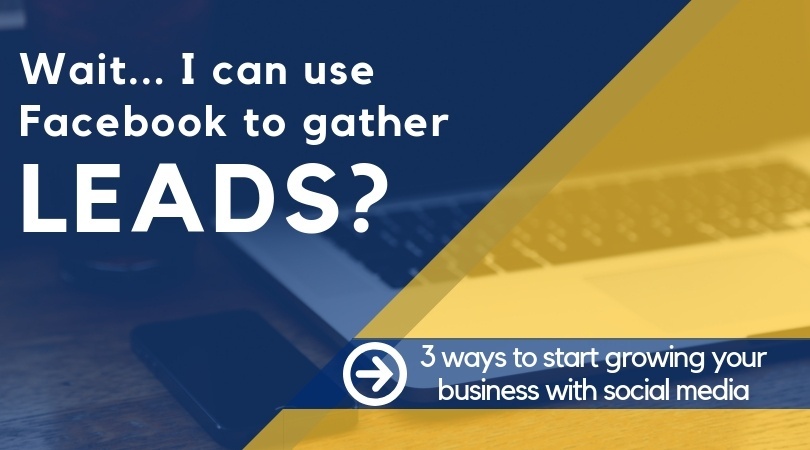Use these simple Facebook marketing tips to cultivate credibility.
Once upon a time, Facebook was a mystical kingdom, only visited by the bravest businesses in search of a futuristic land booming with millennials. But, as the story goes, these millennials shared the land's secret (case-sensitive) password with their friends, parents and grandparents until the kingdom was full of 1.15 billion daily active users from all walks of life. And, in the end, businesses small and large, regardless of their hopes and dreams, have landed on Facebook to find gold and everlasting success. And, for good reason.
The magic of social media isn't a fairy tale.
- Most people check their social media at least once a day. This means that while insurance isn't top-of-mind for most people until it's renewal time, creating an active social media presence allows you to remain relevant all year long.
- Social media can drive people to your website, blog posts or resources. In fact, social media now drives 25.6% of website traffic.
- Word-of-mouth drives 20-50 percent of purchasing decisions. If you see a friend interacting with a business on Facebook, chances are you may view it as a personal endorsement or positive review.
- Social media lets you reach more people with less touch points. How many phone calls can you make in five minutes? A social post that takes you five minutes to develop, could easily allow you to reach 50 people at once.
Here's the problem: the power of social media is not a secret. Your agency is competing with more than 65 million businesses with a Facebook page. However, by using a few Facebook tips for insurance agents, you can stand out from the crowd and make your page a viable part of your marketing strategy.
Here are 3 common Facebook mistakes made by businesses, plus best practices to avoid them:
- Trying to sell... all of the time.
You want me to have a Facebook page for my insurance agency, but you don't want me to try to sell a policy? Yup. That's the idea. Your sales agenda might be the reason you create a page, but social media was made for social interactions, not business transactions. Use social media to establish credibility, learn about your customers and build relationships, which can ultimately lead to more sales.
To start, ditch the "get coverage now" approach. Instead, make insurance relatable by sharing news stories where insurance coverage matters and discuss how a similar event could impact your clients. Become a trusted resource by discussing risk management tips to help your customers avoid preventable claims. And get personal. Comment on local businesses' success stories, answer a client's "request for recommendations" or simply give "likes" when appropriate.
An easy way to balance your social media content is to follow the 10:4:1 rule. For every 15 posts you share:
- Ten posts should be from other sources, like local events, risk management tips or feel-good stories.
- Four posts should link to content you've created like a blog post or resources on your website.
- One post can be a soft sell, like outlining a coverage your clients may not know is available. - Going rogue.
Every post is a new opportunity to reach someone, so disappearing for weeks isn't doing you any favors. Can you remember the last time you went to a business' Facebook page? If you saw they were inactive for a month, what would you think? As we become accustomed to social media as a daily resource, an inconsistent social media presence may make people assume you're out of touch, unorganized or you've closed your business.
While the "magic posting number" changes regularly, generally speaking — you want to aim for one Facebook post a day, between 1-4 PM. Posting daily may seem intimidating, but if you set aside some time each week, you can write out your posts and schedule them directly on Facebook. - Offering nothing of true value.
Think of your entire customer base. Now, focus on one industry that you serve. Then, think of all the attributes that make-up your ideal customer in that niche. Consider their demographics, buying habits, motivations and goals. Make a list of these details and combine them into one imaginary person. Now give them a name, like Firefighter Fred. Firefighter Fred is an example of a persona which can be used across channels in your marketing strategy.
If you're selling a Barbie Dream House, you would use Barbie as your persona. If you're selling a Batcave, you would use Batman.
Before you develop a social post, blog or any other piece of content, think about your persona. Ask yourself: do they care? Is it valuable, new, interesting or important? If Barbie, Batman, Firefighter Fred, Construction Corey or Executive Elizabeth probably won't care, it isn't worth posting.
Good social media habits can develop easily over time. But it's important to remember that social use isn't a one-size-fits-all, or one-size-fixes-all, situation. Depending on the size of your agency and your goals, you might need to adapt other best practices to fit your needs. It's important to analyze your efforts and see where they're best spent.
When you're evaluating your social media efforts, consider these things:
- Reach: how many people see your posts. For business pages, Facebook lists your reach on every post.
- Engagement: likes, shares, comments. This is important because Facebook prioritizes content on pages that you've engaged with. So, if someone likes one of your posts, your posts are more likely to appear at the top of their news feed. Noticing which posts perform best can also help you narrow down the interests of your clients and create more engaging content for the future.
- Referral traffic: figure out how much of the traffic to your agency website is generated from Facebook.
To make it simple, put yourself in the shoes of your ideal customer. Always keep their wants and needs top-of-mind. At the end of the day, servicing our clients is what's most important and social media is now a large part of that. Adopting a few best practices can make your social media presence an added-value for clients and make you their trusted resource for insurance time and time again.
Wondering if this really works?
Jerrad and Kory Coots, Regional Directors of VFIS of Oklahoma, noticed a direct correlation between their bottom-line and their social media usage. Here's their advice:
“In the beginning, don’t get hung-up on likes. You have to be patient and set your priorities. Your priorities should be creating content that is relevant, substantial, personal, surprising, fresh and original. Original is most important – you want your own, local and personal content.”

Bri Cappella, Integrated Marketing Specialist
Bri is an over-enthusiastic dog mom, pop culture fanatic and Instagram addict. She enjoys eating pizza, practicing yoga and hiking.
DISCLAIMER
The information contained in this blog post is intended for educational purposes only and is not intended to replace expert advice in connection with the topics presented. Glatfelter specifically disclaims any liability for any act or omission by any person or entity in connection with the preparation, use or implementation of plans, principles, concepts or information contained in this publication.
Glatfelter does not make any representation or warranty, expressed or implied, with respect to the results obtained by the use, adherence or implementation of the material contained in this publication. The implementation of the plans, principles, concepts or materials contained in this publication is not a guarantee that you will achieve a certain desired result. It is strongly recommended that you consult with a professional advisor, architect or other expert prior to the implementation of plans, principles, concepts or materials contained in this publication.
This blog post may contain the content of third parties and links to third party websites. Third party content and websites are owned and operated by an independent party over which Glatfelter has no control. Glatfelter makes no representation, warranty, or guarantee as to the accuracy, completeness, timeliness or reliability of any third party content. References to third party services, processes, products, or other information does not constitute or imply any endorsement, sponsorship or recommendation by Glatfelter, unless expressly stated otherwise.
Related posts
Here are five ways you can build, expand and strengthen your professional network on LinkedIn.
Telling a story doesn’t have to be long or complicated—in fact, sometimes simple is best.
So, you’ve signed up for LinkedIn, filled in all of the basic information (like your work history and education) and contact information—what’s next?







Submit a Comment